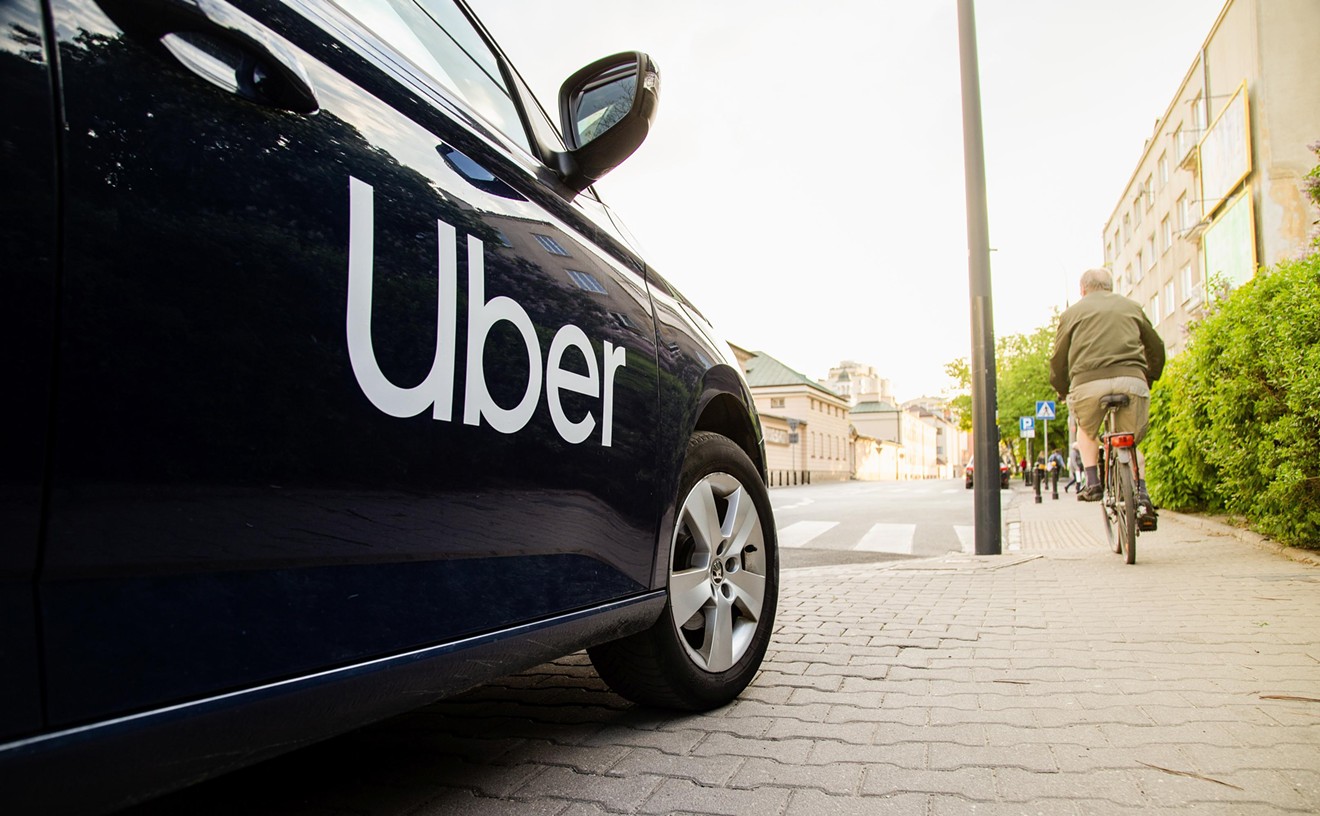
|
He eyes the traffic. As the light turns amber and the cars slow, Willy lunges between bumpers, swinging bags of mamoncillos. He snakes between the Maxima and the Accord, the shiny Lexus and the beat-up Dodge truck, collecting two dollars for each mesh sack of the little green fruit, known as Cuban lychee. He's a mirage. His image shimmers in the heat of the engines and the glaring sun. As traffic moves forward he scurries back to the sidewalk, his knees brushing grilles and taillights on the way. Hustling to a hedge where he keeps his mamoncillos in the shade, he grabs more bags and stands under the awning of a hardware store. Once again Willy eyes the traffic, waiting to jump back into the crush of busy Flagler Street.
"This is difficult work," the 54-year-old Peruvian says in Spanish, perspiration dripping from his brow and soaking his shirt. He closes his eyes and exhales slowly. "This is not an easy way to earn money."
Only the desperate dodge traffic for a living. Willy is a desperate man. He's a mechanic with an injured back from a fall in Peru, here illegally with his wife, who cleans houses. His right arm is in a pressure cast after emergency surgery for a severe case of tendonitis. Willy doesn't have insurance, so he pays his hospital bill piecemeal in cash -- but he doesn't have a lot of cash. He's a poor man, and that's not going to change no matter how many sacks of mamoncillos he slings. He's got a boss who gives him fruit to sell in the morning and then takes 70 percent at the end of the day. Willy keeps 60 cents for each two-dollar bag, a dispiriting economic equation that forces him into traffic six days a week. On the seventh day he goes to church and rests. "I'm very tired," he says with stoic understatement.
Willy is part of the invisible army conscripted into an informal economy where people scratch out a living in America's poorest city. He eludes census takers, tax collectors, the government in general. And he helps make Miami unique. Most big cities have networks of illegal aliens working under-the-table jobs, but Miami's well-entrenched culture of exiles, plus the fact that it is the only large city where the so-called minority population outnumbers the majority, has created a self-sustaining shadow world. Princeton sociologist Alejandro Portes, who has extensively studied Miami, calls it the "enclave economy," a self-reproducing, self-reliant system fueled by an endless supply of new immigrants. This informal shadow economy exists in addition to Miami's vibrant illegal economy, the drug smuggling and weapons smuggling and money laundering that thrives here because Miami is a port city with very close ties to the Caribbean and Latin America.
Portes would argue that Miami's infamous claim to poverty fame is not really its fault, or at least not entirely the result of civic mismanagement. "Miami is caught in the influx of immigration," notes Portes, who co-authored with FIU professor Alex Stepick City on the Edge: The Transformation of Miami. "It is a gateway city, and the income levels of that population tend to be lower." Many of Miami's immigrants come from "economies of scarcity," as Portes puts it. They've learned in their homelands how to survive with meager resources, and they use those skills here as well. Whether they be campesinos or office workers, new arrivals commonly end up taking low-paying transition jobs as a matter of sheer survival -- maids, taxi drivers, kitchen workers. That population tends to support Miami's informal economy. "In part the immigrants need it and in part the immigrants are used to doing things this way," Portes says. (Certainly those coming from Cuba in the past decade are accustomed to relying on black markets for food and other necessities.) Informal economies allow the poor to make ends meet, whether they're in Caracas, Havana, or Miami.
Another factor contributing to Miami's flourishing informal economy is the lack of an industrial sector, which would otherwise provide a base of stable, decent-paying jobs. "The economy of Miami does not offer enough opportunities for formal employment because it's not an industrial economy; it's a service economy," Portes says. "So these people invent their own employment."
With relative ease, in Miami you can live entirely off the books if you choose. You can have an unskilled job like Willy's, unreported and untaxed. With that scant income you can rent any number of modest apartments in places like Little Havana and Little Haiti, where single-family homes are routinely and illegally subdivided into three, four, or sometimes as many as twelve family units. You can clothe yourself in drastically reduced name-brand apparel sold from private homes where you need a trustworthy referral before you can enter. And you can get your health care from a profusion of backroom doctors and dentists.
For his tendonitis, Willy ended up going to Hialeah Hospital, according to a bill he carries in his shirt pocket. But he could have also picked one of numerous unlicensed doctors who service undocumented immigrants afraid that an emergency-room visit might alert the INS. Also appealing is the fact that unlicensed health-care providers are always cheaper and more willing to work with uninsured patients.
That was the case with Eugenio (not his real name), a recent Cuban immigrant who suffered a bad toothache about six months after arriving in Miami. When he couldn't take the pain any longer, a friend put him in touch with a dentist -- the kind who swears you to secrecy when making an appointment.
Eugenio drove with his girlfriend to a home off Flagler Street. The couple entered a door on the side of the house that led into a converted garage. Inside, according to Eugenio's girlfriend, who recounted the visit for New Times, was a pristine waiting room complete with white-tiled floor, couch, and Spanish-language magazines. Through the doorway of another room the girlfriend could see a reclining dentist's chair and a tray set out with what appeared to be sterilized instruments. It turns out Eugenio had an abscess around a molar. The "dentist" cleaned and disinfected the area and had Eugenio return for a followup. Total cost: $60.
The dentist who helped Eugenio is exactly the type of person Enrique Torres deals with on a daily basis. As chief investigator for the state Department of Health's Unlicensed Activities Division, Torres makes his living busting backroom doctors and dentists, a seemingly endless task. "There are thousands of unlicensed medical providers in Miami-Dade," Torres says. "At least 300 to 400 dentists. There are also doctors, psychologists, pharmacists, surgeons, midwives. You name it and you can find it. You can walk into a dozen clinics in Little Havana and find unlicensed doctors and nurses." According to Torres, a new immigrant's unfamiliarity with American medical practices makes it easier for unlicensed practitioners to operate without scrutiny: "In some countries you see a white lab coat and you think that person is God."
Miami's informal economy is not solely the product or province of recent immigrants. For example, the city's traditionally black neighborhoods, which for decades suffered from economic as well as racial segregation, created their own alternative markets for goods that would otherwise be unavailable. Liquor, clothes, food, and more could be bought from the trunks of cars in Overtown. Rapper Luther Campbell has recounted how he got his start selling cassette tapes on the streets of Liberty City.
"There was a whole lot of stuff like that where I grew up in Liberty City," says Brian Dennis, a community activist. "There was the frozen-cup lady. She sold frozen Kool-Aid in a cup from her house. There was an old man with a truck and every day after school he would make a killing selling us candy and soda. When you see older people selling like that, it means times are tough and these people are just trying to make ends meet."
Another example of the informal economy's versatility and resilience is the fact that it attracts the children of immigrants, a second or third generation that is now fully integrated into the formal workforce. Anecdotal evidence abounds. Miami is the home of the friend who knows somebody who can paint your car, fix your roof, move your furniture, or landscape your home. For instance, Patricia, born in Cuba but raised in Miami, has a well-paying job as a saleswoman, leases a new car every few years, and owns her own home. But when she needed a suit for work, she didn't go to Bloomingdale's. A friend told her about a place where she could get amazing deals. "Someone from work whose sister had gone there told me about it," Patricia recounts. "I called first and had to say who recommended me." After setting up an appointment, Patricia drove to a home on Miami's western edge. "It was a really nice house, three or four bedrooms, but there wasn't any furniture in it," she says. In the living room were racks of new suits, tags still attached. Patricia purchased a $400 Ralph Lauren woman's suit for $150. She didn't know where the clothes came from and she didn't ask.
In 1987 Miami police arrested one such home-shopping clothier, Emeterio Marino Pijeira, for selling stolen men's suits from his Shenandoah duplex. When investigators began digging they discovered some of Miami's most prominent citizens among his customers, including Dade County Manager Sergio Pereira, a self-confessed clotheshorse; Miami Commissioner Rosario Kennedy, who bought two $150 suits for her sons; and former statewide prosecutor John Hogan, who bought two suits for $125. Police said the suits had been stolen from retail stores throughout the county.
Willy from Peru won't be buying fancy suits anytime soon. He's concerned with economic survival, not looking good. The streets near his Flagler outpost are teeming with others like him, grim foot soldiers in poverty's trenches. A few blocks east two men are independently selling soda and water. A third man walking along the sidewalk is hawking Timex watches still in their boxes. Willy shares his intersection with a stern-faced woman who sells beverages to thirsty commuters.
At this moment the streetlight has turned red and the cars have stopped. But Willy stands still. From under the hardware store's awning he motions with his eyes to the line of traffic, where a Miami police cruiser idles. "La policía," Willy whispers. If they spot him they might ask to see his street vendor's permit, which he doesn't have. He's already received one $28 ticket from a Miami cop, so he sits this one out and lets the line of potential customers drive off.
That's tough. He says he's under the gun to sell all his mamoncillos today. "They won't be any good tomorrow," he explains. "And if I have any left over, there's going to be trouble with the boss."










